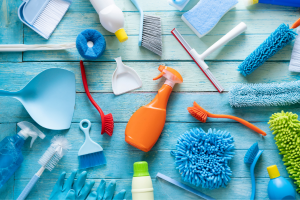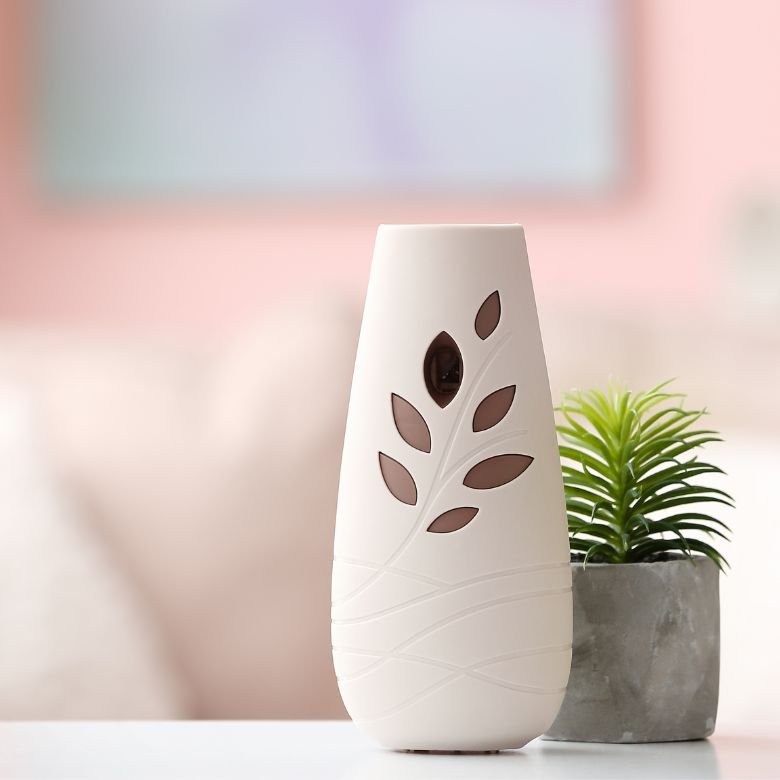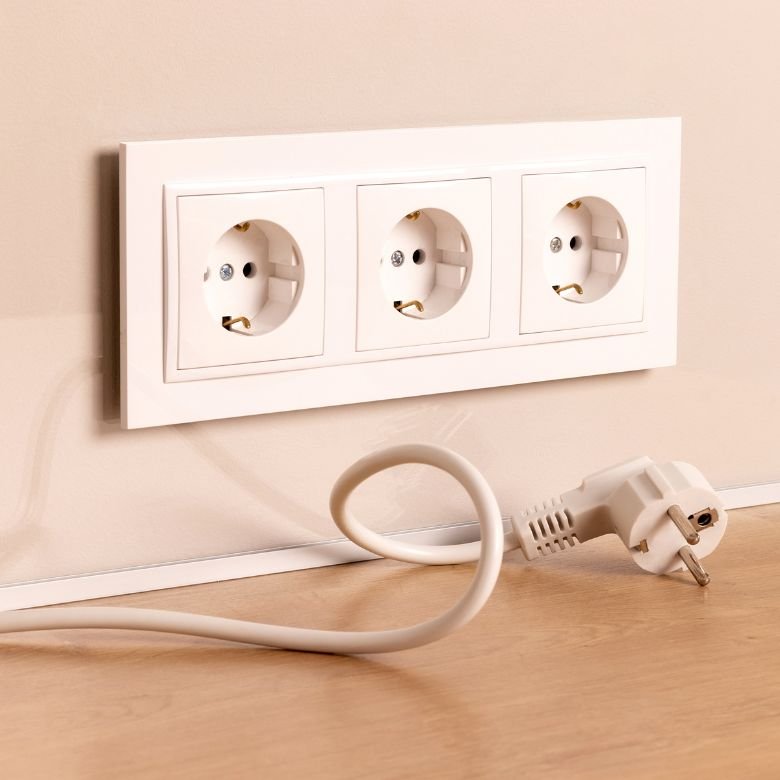Many people do not even realise that there is much more to chemistry than harmful reagents and toxic substances. Chemistry also includes nature and the multitude of things we deal with every day. When you look around a regular room, you may notice products such as cleaning agents, disinfectants, air fresheners, furniture, panelling, foam mattresses, cables and various office supplies. Each of these things is made up of a variety of chemical compounds.

Cleaning agents
These products, otherwise known as detergents or surfactants, are designed to reduce the surface tension of water. The higher the tension, the poorer the wetting of the surface and, as a result, also the more difficult the removal of dirt. Cleaning agents therefore support the mixing of contaminants with the solvent. Their mechanism of action is based on a number of properties:
- changing the pH of the soiled surface, resulting in the breaking of hydrogen bonds responsible for the persistence of dirt particles on the surface. Some substances also decompose under the influence of changes to the environmental conditions;
- lowering water hardness, making surface wetting faster and more efficient. This increases the solubility of ionic compounds and promotes the breakdown of certain components;
- foaming, which not only increases the contact surface between dirt particles and detergent, but also pushes out released dirt particles, preventing its reattachment to the cleaned surface.
There are three most widely used groups of surfactants:
- anionic surfactants, which are the strongest surfactants used mainly for oily and greasy soils. The biggest problem with their application is the calcium and magnesium cations present in hard water that deactivate surfactant molecules;
- non-ionic surfactants that also have strong degreasing properties. However, they are mainly used in laundry products and hand dishwashing liquids. In addition, because they have no electrical charge, their activity is not affected by the level of water hardness;
- cationic surfactants, or mainly softening agents, which are often used as an additive to fabric softeners. Since they exhibit bactericidal activity, they are used in formulations designed for disinfection.
As far as disinfection chemistry is concerned, it is important to remember that both fungi and bacteria even within the same species can differ significantly from one another, including in terms of resistance to germicides and fungicides. The effectiveness of disinfectants depends on the active substances used, their concentration, duration of action, temperature used and the presence of additional contaminants. The active substances used, such as alcohols or other oxidising compounds, usually aim to denature proteins and break the bacterial cell membrane. Other substances, including aldehydes and quaternary ammonium compounds, such as benzalkonium chloride, are additionally able to destroy their genetic material.
Air fresheners
Scents diffused in the room can also be a sign of the presence of chemicals. All kinds of air fresheners have a number of chemicals in their composition, such as alcohols, mineral oils and antibacterial chemicals. Non-ionic surfactants such as fatty alcohol ethoxylates are often used in the role of solubilisers of fragrances. Unlike air fresheners, neutralisers are designed to eliminate unpleasant odours. This is possible thanks to the use of chemical compounds that react with the volatiles of unpleasant odours, transforming them into other scents.

Furniture
Another – not very obvious – chemical aspect of any room is furniture. There are many materials used for furniture production, including:
- wood, whose chemical composition includes such compounds as cellulose, hemicellulose and lignin. In terms of elements, carbon accounts for about 49.5% of wood composition, oxygen 43.8%, hydrogen 6.0%, nitrogen 0.2% while other elements occur in negligible amounts. Depending on the type of wood, you will find varying proportions of sugar, protein, starch, tannins, essential oils, gums and minerals in its composition;
- melamine boards, are made of melamine, an amine aromatic compound derived from triazine. Such boards are characterised by high thermal and chemical resistance and durability;
- glass, the components of which include quartz sand, or silicon dioxide, additives such as sodium carbonate and calcium carbonate, fluxes and metal oxides as colourants;
- polymers, such as, polycarbonate, polypropylene and ABS, or acrylonitrile-butadiene-styrene thermoplastic polymer. Such materials are highly resistant to cracking and scratching, and also to external factors such as moisture.
This category also includes panels, for instance, vinyl panels made of powdered sedimentary rock, polyvinyl chloride and a stabiliser.
Read more about chemical raw materials for the furniture industry.
Foam mattresses
Another industrial product with a lot of chemicals in it is the entire range of foam mattresses. Such foam is constructed exclusively of synthetic materials. It consists of layers of polyurethane foam with fire-resistant additives such as gel, wool, latex foam, cotton or polyester. The components of polyurethane foam mainly include:
- polyols – a group of multivalent alcohols with binding properties;, they are the basic raw material that reacts with other materials to produce polyurethane foam;
- diisocyanates, which can take either organic or inorganic forms, they are a more reactive substrate in the reaction to obtain polyurethane foams;
- blowing agents that enable carbon to be added to the mix.
Other foams are used, too, including latex foam, which is a mixture of synthetically obtained latex and natural rubber tree milk.
Read more about polyurethanes.
Cables and wires
Every home also comes with cables and their covers. Take an electrical cable, for example: it is nothing more than a connector between the power source and the receiver, which consists of conductors made of copper or aluminium. These elements are excellent conductors, which is why they are so popular in this application. Copper conductors are characterised by greater mechanical strength and can easily be connected. For this exact reason, aluminium cables in a sheath made of copper are also produced. Wires can come with specific markings, indicating the material from which they are made. The letter ‘A’ indicates an aluminium wire, and ‘F’ means one made of steel. Any non-labelled wires are copper by default. In addition to the metal wire itself, cables also use insulating materials. These are all kinds of plastics with the most common being PVC, which is plasticised and granulated polyvinyl chloride, rubber, which is an elastomer made up of aliphatic polymer chains such as polyolefins cross-linked by vulcanisation, and polyethylene.

Office supplies
All kinds of office supplies are essential to our daily work. It would be hard to find a home that doesn’t have items such as glue, duct tape, paper, pens, ink pens, printer toners or colour highlighters. You might not call them chemistry at first glance, but take a closer look:
- The action of glue comes from mechanical adhesion, a situation in which two surfaces adhere to each other due to the anchoring forces of substances present on their surfaces. The most important ingredient in the formulation of glue is a polymer, either synthetic or natural, in the form of a colloidal suspension or one that takes the form of colloidal suspension when mixed with a hardener, plasticiser or other modifiers. The most popular glue sticks include substances such as cyanoacrylate and PVP, or polyvinylpyrrolidone. Cyanoacrylate glues are made of methyl, ethyl and alkoxy.
- The action of adhesive tape is similar to glues and is also based on the forces of adhesion and cohesion. Adhesion alone results in the ability of physical bodies to surface bond, while cohesion is responsible for the consequences, namely the durability of the bond and the aesthetic qualities after the tape is peeled off. Every tape consists of a carrier, a flexible plastic, and an adhesive layer on one or both sides of it. An ordinary Scotch tape most often has an acrylic adhesive layer. Its production involves making an acrylic emulsion, which is then mixed with a crosslinking agent. It is characterised by high strength, resistance to moisture and low temperatures, but is considered as a lower-quality tape adhesive. Much more stable is a tape with natural rubber adhesive, also in a wide range of temperatures. However, it is mainly used to seal heavy parcels and cartons. A ‘hot-melt’ adhesive made of synthetic rubber can be used as a substitute in this case.
- From a chemical perspective, paper is a cellulose pulp with added fillers to provide the desired smoothness, strength or colour. Cellulose itself is a chemical compound belonging to the polysaccharide group, and its structure includes about 3,000–14,000 glucose molecules linked in a linear manner by α-β-1,4-glycosidic bonds. Depending on the intended application of the paper, the most common additives used include kaolin, talc, gypsum chalk and dyes.
- A variety of chemicals are used in the production of ball pens, from metals to plastics. Pen tips, for example, can be made of an alloy of copper and zinc, or brass. However, the ball pen body, the ink holder and the frame of the pen are usually made of plastic or aluminium. The ink, on the other hand, is mainly an aqueous solution of pigment that contains insoluble particles. Like fountain pen ink, ball pen ink also contains polymers and stabilisers that are responsible for the texture and flow of the product. Polyvinyl chloride and polyvinyl acetate are often used as stabilisers to prevent ink from clotting. The solvent in most cases is water, sometimes petrochemicals composed mainly of carbon and hydrogen. In addition, manufacturers use substances such as glycerides to make the ink glide better on paper, triethanolamine to regulate its pH or clay containing silicates as a filler.